An overshot jaw is when the upper jaw extends further out than the lower jaw, with the horse having an overbite (also called a parrot mouth). When the lower jaw extends farther out than the upper jaw, we call this an undershot jaw,with the horse having an underbite (also referred to as a monkey jaw or sow mouth).
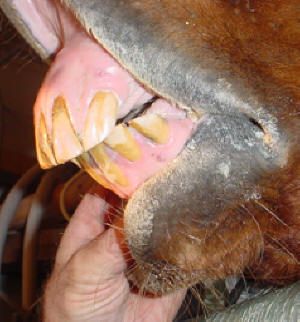 Both defects can affect the chewing of the horse and the horse’s ability to clip grass.
Both defects can affect the chewing of the horse and the horse’s ability to clip grass.
Parrot mouth has several other names and these include: brachygnathism, overshot maxilla, buck tooth, undershot jaw or overbite.
The definition of a parrot mouth is when the top incisor teeth’s front edge is further forward that that of the lower teeth.
There are many different degrees of parrot mouth from minor to severe. In minor cases, the upper and lower incisors still meet, but are not perfectly aligned, but in severe cases, the two do not meet at all.
It is important that the horse’s incisor bite be checked with the head in the normal resting position and not raised up high. Raising the head high, or extending the poll joint, will cause the lower jaw (mandible) to slide backwards (caudally) slightly (approx 3- 10 mm). Conversely, when the head is lowered and the poll flexes, the lower jaw (mandible) slides forward.
This backward and forward sliding of the jaw when the head is raised and lowered is known as Rostro-Caudal Movement (RCM). It is a normal process which is required for normal chewing and comfort to the horse when ridden. So even though most of the jaw movement when eating is from side to side (lateral movement), there is also a small amount of backwards and forwards movement of the lower jaw (RCM).
Parrot mouth may occur in any breed of horse, and it has a reported incidence rate of 2-5 %. This is fairly significant when you think that 2-5 out of every 100 horses have parrot mouth to some degree.
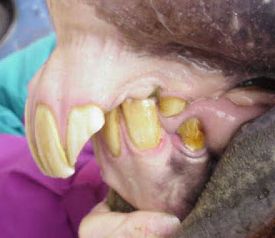 Parrot mouth in a horse is often not present as a newborn foal, but becomes apparent when the horse is over 1-6 months old.
Parrot mouth in a horse is often not present as a newborn foal, but becomes apparent when the horse is over 1-6 months old.
The cause of parrot mouth is often not fully clear. Several causes are possible including genetics, trauma and illness as a foal near a period of rapid growth.
The condition can result from the top jaw (maxilla) developing too long, or the bottom jaw (mandible) developing too short. Usually it is the lower jaw that is too short. When it is the upper jaw that is too short, this condition is often referred to as monkey jaw or sow mouth. But anything which interferes with the match up of the top and bottom jaws can cause a horse to have an overbite or underbite.
As far as genetics go, parrot mouth is NOT directly inheritable. It is rare to see an individual sire or mare throwing an abnormally high number of parrot mouthed foals. The most common cause of it is when a mare is bred to a stallion with a very different head type than she has. Surprisingly, these two animals often have normal teeth structure, yet when they are bred, the mismatch is so great that a parrot mouthed offspring is produced.
This occurs most often when a stocky and short, wide headed stallion is bred to a lean long headed mare. Thus a breeder needs to be careful and considerate even of head type when planning to breed a superior foal.
It is important to remember that malocclusions in horse’s teeth (when they are not in the correct positioning and alignment) is poorly understood when it comes to how inheritable it is, and is often a very complex mismatch of many genes. Having a badly malformed mouth in your horse may present a risk in breeding, but certainly doesn’t mean that animal will throw offspring with a similar condition.
One strategy could be to not re-mate a mare to a particular stallion if a parrot mouthed foal is produced by that mating.
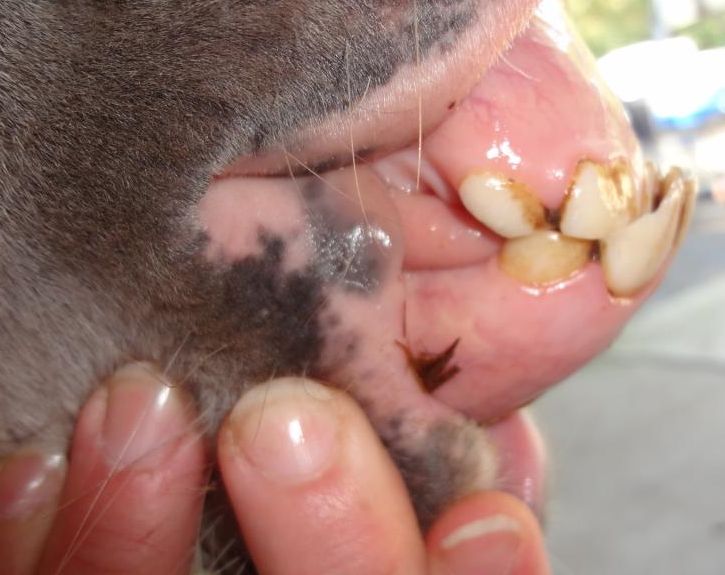 The real problems with being parrot mouthed are due to the fact that horses’ teeth are hypsodont teeth — that means that they have long crowns up in the bone and continue to erupt or move into the mouth throughout life — up to a point where there is no more tooth left to erupt into the mouth. If they are not opposing another tooth, they continue to erupt into the mouth to a point where they are a problem and dig into the opposite jaw or the roof of the mouth.
The real problems with being parrot mouthed are due to the fact that horses’ teeth are hypsodont teeth — that means that they have long crowns up in the bone and continue to erupt or move into the mouth throughout life — up to a point where there is no more tooth left to erupt into the mouth. If they are not opposing another tooth, they continue to erupt into the mouth to a point where they are a problem and dig into the opposite jaw or the roof of the mouth.
Horses’ teeth do not grow indefinitely like rabbits’ teeth, but for some time they continue to erupt into the mouth — with the purpose being to replace the tooth which is worn away during the chewing process.
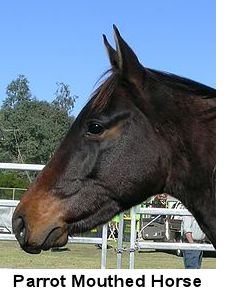 Because a paddock grazing horse may on average chew approximately 20 million times per year, the highly repeated grinding of tooth on tooth, or tooth onto fibrous feed material will lead to wearing away of the tooth. Thus new tooth needs to erupt into the mouth to replace the tooth which has been worn away. This tooth eruption process usually continues up until the horse is 15- 20 years of age.
Because a paddock grazing horse may on average chew approximately 20 million times per year, the highly repeated grinding of tooth on tooth, or tooth onto fibrous feed material will lead to wearing away of the tooth. Thus new tooth needs to erupt into the mouth to replace the tooth which has been worn away. This tooth eruption process usually continues up until the horse is 15- 20 years of age.
The eruption process of teeth works fine if the teeth all line up even and oppose one another. But if they are not matched, then the tooth which is not opposed will continue to erupt into the mouth and become longer and longer.
As the elongating tooth or teeth become more prominent, they may cause the tooth to be moved or forced out of its normal position and may also restrict the whole jaw’s normal RCM (rostro-caudal movement) while eating or when ridden.
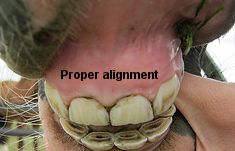 Some examples of the secondary effects of parrot mouth are elongated lower incisors — where the lowers may cause ulceration of the roof of the mouth’s (palate) lining (mucosa). This obviously can be painful to the horse and restrict its ability to graze properly.
Some examples of the secondary effects of parrot mouth are elongated lower incisors — where the lowers may cause ulceration of the roof of the mouth’s (palate) lining (mucosa). This obviously can be painful to the horse and restrict its ability to graze properly.
It is not surprising that it is uncommon to see badly parrot mouthed horses surviving into their late teens.
